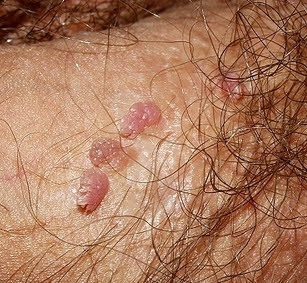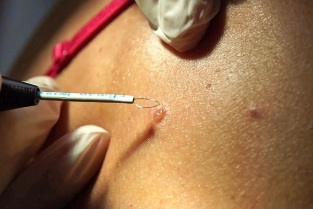
More often than not, people no doubt have human papillomavirus (HPV) in their body. This is due to the fact that papillomavirus is usually present in a latent form, suppressed by natural immunity. The problem arises when it spins out of control and begins to actively manifest itself as growth on different parts of the body. Men are more likely to suffer from the effects of the virus than women. Less is, however, for them, its effect can turn into serious problems on the penis in the form of papilloma.
due to event
Viral DNA enters the body via microcracks in the skin or mucous membranes. If a person's immunity is weak, the first manifestations of HPV will appear several months after infection.
Up to 80% of transmission is via the sexual route. Barrier reduces the risk of contraceptive infection, but does not eliminate it completely.
Other methods of infection:
- domestic route.The virus is transmitted along with the personal belongings of an infected person: clothing, hygiene items, etc. If there is damage to the skin, there is an increased risk of transmission even mildly. This pathway is characterized by infections of the low-oncogenic type of virus. They do not give rise to serious health problems, but forms of genital warts, papillomas and warts, Causing cosmetic defects.
- from mother to child.If the mother was infected with HPV during pregnancy and delivery and gave birth naturally, the child is likely to be infected.
If a person's immunity is good, the virus does not manifest itself and can remain in the body for a long time in latent form. Therefore, it is not infection with the virus that is dangerous, but weak immune system. Being, which leads to the activation of HPV.
There are several factors that affect the likelihood of the virus becoming stronger:
- chronic diseases;
- hormonal problems;
- incorrectly selected contraceptive or its complete absence;
- viral infection;
- alcohol, smoking or long-term use of antibiotics;
- Constant tension.
All these factors negatively affect the immune system. If a man does not have a stimulating factor in life, but many, it will lead to more rapid development of papilloma virus.
symptoms
Often, papillomas appear only externally, although, in some cases, nonspecific symptoms can occur:
- itching and burning during intercourse;
- pain on touching papilloma;
- accumulation of urine in the folds of the penis;
- unpleasant smell in the affected area.
Furthermore, neoplasm can not only develop and affect the area of the penis, but can also appear on the anus and pubis.

what does papilloma look like
Penile papilloma is a small neoplasm. At first, she may appear alone, but without proper treatment, the number of papillomas increases. However, they may merge with each other.
These growths look like flesh-colored or pink-colored cauliflower. Most often they are localized in the forehead, on the head and palms. Less commonly, they are diagnosed in the urethra and scrotum. Papillomas are small. Can also appear as white pimples that appear in long rows. This form is typical for localization in the area of the bridge.
One of the manifestations of HPV is Buschke-Levenshtein warts. It is distinguished by its rapid growth, excellent shape, and resistance to a variety of treatments. Its presence is due to the many existing papillomas and warts that merge together. And form a large wound area. The presence of Condyloma Buschke-Levenshtein is dangerous because the cells transformed by it can easily develop into cancer.
which doctor to contact
As a rule, a urologist is concerned with the diagnosis of papilloma in men. If you have genital warts in the anal area, you can also consult a dermatologist or a proctologist. However, papillomas usually remove. A surgeon is referred for. Overall, the diagnosis is made in several stages:
- The urologist examines and interviews the patient.Verbal interrogation is necessary to assess the patient's lifestyle and establish the cause of the virus infection. Visual examination involves assessing not only the position of the penis, but also adjacent organs - scrotum, rectal area. This is necessary to complete the picture of localization.
- urethral smear.determines the presence of various sexually transmitted diseases.
- PCR.This analysis not only shows the presence of HPV in the body, but most likely also determines its type.
- mitoscopy. This procedure is an examination of the urethra if the papillomavirus has infected the phrenum.
- After removal of papilloma, the doctor may order a biopsyto assess the status of the removed tumor. This is necessary to reduce and ensure the risk of developing cancer. Is that papilloma is benign.
In this case, a survey of both partners is desirable. Usually a woman is also infected with one type of papillomavirus. If only one man is treated, it is very likely that he will be a little later. Will get sick again.
Why papillomas are dangerous
Human papillomavirus often accompanies other related diseases. The presence of papillomas in the glandular region contributes to the accumulation of urine in the folds. This creates conditions for the emergence and growth of various microorganisms, which subsequently cause infection. They can provoke caries around papillomas, and can also contribute to inflammation of the urethra and testicles. These diseases cause problems like urination, pain, and high fever.
Another danger is the trauma to the newborn, causing bleeding. This is due to the fact that many blood vessels are formed around the papilloma, which supplies them with blood. Minor damage can also lead to infection on injury.
Also, the neoplasm may rub while walking, causing pain and discomfort to the man.
HPV and Cancer
When the virus has just begun to spread, the neoplasm is sporadic and benign. Without treatment, they grow and merge with each other. Over time, cells turn into thin masses.The risk of cancer is particularly high if a person is infected with a highly oncogenic type of virus - 16 or 18.They contribute to the appearance of cancer of the penis and bladder.
treatment of papilloma
HPV treatment involves not only removing its external manifestations, but also strengthening the immune system, thereby preventing the manifestations of the virus.Immunostimulating drugs are used to maintain immunity.
As an antiviral drug, an ointment that suppresses the multiplication of the virus and removes small growth is effective. It does not always cope with the task of complete removal, but it prevents the appearance of new growthAntiviral ointment is prescribed to stimulate immunity. The ointment does not remove papillomas, but promotes the activation of cells of the immune system, which inhibits their growth and development.

removal methods
There are several ways to get rid of the visible new growth:
- laser removal.A laser beam acts on the papilloma, which burns the growth completely. At this place a crust is formed, which subsides after a few weeks. The method is considered effective due to the absence of relapse. Removal is performed under anesthesia. There is no bleeding, no scar or scar.
- Cryodes directive.Papillomas are exposed to liquid nitrogen. It freezes the desired area immediately, over which the neoplasm collapses and dies. The disadvantage of this method is the inability to control the depth of the effect of cryodestruction. RemovedAt the site of papilloma, a crust also remains, which disappears after a while.
- radiosurgery.The principle of this method is similar to laser removal. Radio waves do not leave scars and scars, and the procedure is preformed by initial anesthesia with a special spray. There is no complication after that, and the body recovers quickly. goes.
- electrocoagulation.Growth is affected by an electric current, which causes the leg to end, after which the papillus disappears. Superficial anesthesia may be given if necessary. The procedure takes several minutes, extensive and inexpensive. But this method is capable of leaving scars after treatment.
- surgical intervention.It is used in rare cases when the tumor becomes very large. It is done under anesthesia, has a long healing and trauma. It is good to have it removed for histological examination. Allows development to be saved.
The cost of each method depends on the complexity of the work, the size and number of papillomas to remove.
Before choosing a method, consult your doctor. He will tell you what is best to use in your situation, tells you in detail how the procedure is performed. Also, to remove neoplasm. Subsequently, it is advisable to take material for histology. It is necessary to determine whether the process of degeneration of malignant people of benign neoplasm has begun. This method can detect early cell changes and prevent the spread of cancer. Will help prevent














































































